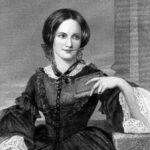People always have mixed perceptions, thoughts, or beliefs about death. When people think about death, they might experience fear or anxiety as to what the afterlife holds for them. Writers in different time periods throughout history have used different figures to represent death itself, as well as the different feelings toward dying and what happens after death. In 1863, Emily Dickinson wrote the slant rhyme poem “I heard a Fly buzz – when I died-,” which gives the reader a rare glimpse of dying from the view point of someone who is already dead. Death is a part of life no matter what personal belief one has, and according to Emily Dickinson, life may continue after death.
Emily’s poem is told in the past tense by person who has already died. Emily Dickinson uses past and present tense words together, which indicate a transition between life and death. The poem is ironic and unique because there is a concern with a menial matter such as a buzzing fly at the final moment of life. In the first stanza the narrator states, “I heard a Fly buzz- when I died-“. An annoying fly is usually not of utmost importance when one is dying. Death is perceived as a serious time in life. Emily Dickinson sets the tone of the poem intending to shock the reader, which is what happens.
The speaker describes a “Stillness in the Air-/Between the Heaves of Storm-” (3-4). Furthermore, the room quiets as the narrator and the mourners are waiting for the last breath of life to leave. The atmosphere of the room is like the calm before the storm. There are no trumpets or harps from Heaven playing, God, a higher power, or any beautiful angels to be seen. In the room there is just a quiet waiting and the pesky fly. The family of the narrator are in mourning for what is to come, “The Eyes around- had wrung them dry-“ (5). The family grieves and now they are waiting, “For that last Onset-when the King/ Be witnessed-in the Room-” (7-8). In the first part of this line, the author uses an oxymoron by stating “that last Onset”. Last means an “end,” while the definition of onset is a “beginning.” The king is a symbol of God or death. The narrator is signifying a belief in religion with the mention of the “King.” The writer is affirming a belief in life after death.
There is sadness in the narrator stating, “I willed my Keepsakes” (9). Making a will is the last and final way of ensuring the narrator’s previously-owned possessions staying with loved ones after death. Most people fear death, the tone of the narrator is merely one of sad acceptance. At the moment of disclosing the narrator’s will, “There interposed a Fly-,” which means the fly once again is interrupting (12). The description of the fly changes in stanza thirteen as the narrator states, “With Blue- uncertain stumbling Buzz-,” thus explaining the fly is no ordinary house fly but a metaphorical figure representing death. Writers often associate flies with death and decay. Flies also feed on rotting flesh. The blue buzz indicates a noise that is blue, which is impossible because a sound cannot be a color. However, blue is often associated with the sky, which is related to thoughts of Heaven or tranquility.
The fly cuts the narrator’s connection with life much like the Grim Reaper might, “And then the Windows failed- and then/I could not see to see-“(16). The narrator’s eyes used in this life are now closed. The narrator could not see, but could still hear. Hearing is the last of the five senses to go before death. There are odd and disconnected feelings toward death throughout the entire poem, when in fact the narrator has been dead the entire time. Ironically, the buzz from the fly seems to be the only sign of life in the entire poem. The passage of death has an unsettling, disconnected tone but is not scary or painful.
Emily Dickinson’s poem “I heard a Fly buzz- when I died” is told by a narrator who uses past tense to describe the final moments of their life. The poem gives the reader an inside look into the final moments of death from someone who has already died. The fly is the central figure representing the oncoming of death. The poem is full of many metaphors and similes, such as the king mentioned in the poem who represents a belief in religion. The wording of the poem affirms Emily Dickinson’s belief in life after death. The poem has a short title but is deep in meaning. Death is inevitable to all who are born, although not all deaths are disturbed by a pesky fly.
References
Dickinson, Emily. “I heard a Fly buzz- when I died.” Responding to Literature”. 5th Edition. Ed. Judith A. Stanford. McGraw-Hill, 2006. 1188




